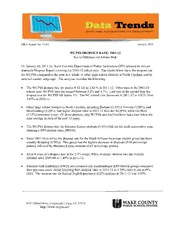
ERIC ED564402: WCPSS Dropout Rate: 2011-12. Data Trends. D&A Report No. 13.02 PDF
Preview ERIC ED564402: WCPSS Dropout Rate: 2011-12. Data Trends. D&A Report No. 13.02
D&A Report No. 13.02 January 2013 WCPSS DROPOUT RATE: 2011-12 Kevin Gilleland and Juliana Muli On January 10, 2013 the North Carolina Department of Public Instruction (DPI) released its annual statewide Dropout Report covering the 2011-12 school year. The charts below show the dropout rate for WCPSS compared to the state as a whole, to other large school districts in North Carolina, and by selected student subgroups. The analyses revealed the following: (cid:120) The WCPSS dropout rate for grades 9-12 fell to 2.83 % in 2011-12. Other than in the 2002-03 school year, WCPSS’ rate has ranged between 3.2% and 4.7%. Last year is the second time the dropout rate for WCPSS fell below 3%. The NC overall rate decreased in 2011-12 to 3.01% from 3.43% in 2010-11. (cid:120) Other large school districts in North Carolina, including Durham (3.55%), Forsyth (3.38%), and Mecklenburg (3.20%), had higher dropout rates in 2011-12 than did WCPSS, while Guilford (2.15%) remained lower. Of those districts, only WCPSS and Guilford have had a rate below the state average in each of the past 13 years. (cid:120) The WCPSS dropout rate for Hispanic/Latino students (4.95%) fell for the sixth consecutive year, marking a 50% decline since 2005-06. (cid:120) Since 2007-08 (6.84%), the dropout rate for the Black/African-American student group has been steadily dropping (4.58%). This group had the highest decrease in dropouts (0.86 percentage points), followed by Hispanic/Latino students (0.83 percentage points). (cid:120) After 8 years of a dropout rate in the 2-3% range, White students’ dropout rate has steadily lowered since 2007-08 to 1.49% in 2011-12. (cid:120) Students with disabilities (SWD) and economically disadvantaged (ED) student groups continued their previous years’ trend, lowering their dropout rates in 2011-12 to 5.39% (SWD) and 4.69% (ED). The dropout rate for limited English proficient (LEP) students in 2011-12 was 3.05%. 5625 Dillard Drive, Crossroads I, Cary, NC 27518 http://www.wcpss.net/ WCPSS Dropouts 2011-‐12 D&A Report No. 13.02 WCPSS RATE vs. LARGE NC SCHOOL DISTRICTS WCPSS Mecklenburg Durham Forsyth Rate 2.83% 3.20% 3.55% 3.38% Count 1236 1278 362 540 Note: Dropout counts are unduplicated within a single school year. For example, a student who drops out more than once within a school year is counted only once as a dropout for that year. Students who drop out from more than one school year are counted as dropouts for each of those years. Figure 1 NC AND WCPSS DROPOUT RATES, 1998 – 2012: GRADES 9 – 12 8.0 6.8 6.4 7.0 5.7 6.0 5.3 4.8 4.9 4.7 5.0 5.2 5.0 4.3 5.0 3.8 3.4 4.0 3.0 4.7 23..00 4.1 3.7 3.5 3.4 3.7 3.9 4.2 4.2 3.5 3.5 3.2 NC 2.8 2.8 WCPSS 1.0 0.0 Note: *The 2002-03 dropout rate is higher than the rate DPI reports because additional dropouts were discovered after the official data submission to DPI. Figure 2 DROPOUT RATES FOR SELECTED NC SCHOOL DISTRICTS, 1999 – 2012: GRADES 9 -‐ 12 7.0 6.5 6.0 5.5 5.0 4.5 4.0 3.5 3.0 2.5 2.0 02-‐ 99-‐00 00-‐01 01-‐02 03-‐04 04-‐05 05-‐06 06-‐07 07-‐08 08-‐09 09-‐10 10-‐11 11-‐12 03* Durham 6.1 4.6 6.2 5.8 5.9 5.7 5.2 4.9 4.2 4.3 4.3 3.7 3.6 Forsyth 6.4 5.5 5.8 5.3 5.2 5.0 5.7 6.4 5.5 4.8 4.1 3.8 3.4 Guilford 6.0 3.9 3.8 3.0 3.1 3.0 3.4 3.0 3.3 3.1 2.8 2.7 2.2 Mecklenburg 6.8 5.8 4.8 4.0 4.5 3.1 4.6 6.4 5.9 5.0 4.2 3.6 3.2 WCPSS 4.1 3.7 3.5 2.8 3.4 3.7 3.9 4.2 4.2 3.5 3.5 3.2 2.8 NC 6.4 5.7 5.3 4.8 4.9 4.7 5.0 5.2 5.0 4.3 3.8 3.4 3.0 Note: 1. *The 2002-03 dropout rate is higher than the rate DPI reports because additional dropouts were discovered after the official data submission to DPI. 2. To facilitate layout, this figure displays percentages for y-axis starting from 2.0. 2 WCPSS Dropouts 2011-‐12 D&A Report No. 13.02 Figure 3 DROPOUT RATES BY ETHNIC GROUPS, 1999 – 2012: GRADES 9 -‐ 12 10.0 8.0 6.0 4.0 2.0 0.0 99-‐00 00-‐01 01-‐02 02-‐03* 03-‐04 04-‐05 05-‐06 06-‐07 07-‐08 08-‐09 09-‐10 10-‐11 11-‐12 Hispanic/Latino 8.7 7.2 7.7 6.5 9.0 8.8 10.1 9.2 8.8 7.4 6.9 5.8 5.0 Black/African-‐American 7.0 6.1 6.3 3.9 5.4 6.0 5.8 6.6 6.8 5.7 5.6 5.4 4.6 Multiracial 5.5 4.8 4.1 4.8 3.4 4.7 3.8 5.8 4.3 3.3 3.5 2.7 2.7 White 3.0 2.7 2.2 2.0 2.2 2.1 2.3 2.3 2.2 1.8 1.9 1.7 1.5 Asian 2.3 1.3 0.9 2.4 1.6 1.9 1.7 1.6 1.4 1.0 1.6 1.0 1.0 WCPSS 4.1 3.7 3.5 2.8 3.4 3.7 3.9 4.2 4.2 3.5 3.5 3.2 2.8 Note: 1. *The 2002-03 dropout rate is higher than the rate DPI reports because additional dropouts were discovered after the official data submission to DPI. 2. Asian and Multiracial student groups constitute less than five percent of the total dropout group; therefore, their rates may fluctuate more from year to year than rates for the other ethnic subgroups. A separate rate is not reported for Native American and Pacific Islander students due to low numbers in the groups. Figure 4 DROPOUT RATES BY SUBGROUP, 2006 – 2012: GRADES 9 -‐ 12 10.0 8.0 6.0 e t a R 4.0 2.0 0.0 2006-‐07 2007-‐08 2008-‐09 2009-‐10 2010-‐11 2011-‐12 Students with Disabilities 7.5 7.7 6.5 7.9 6.5 5.4 Economically Disadvantaged 8.4 6.5 5.1 5.3 5.3 4.7 Limited English Proficient 3.0 Note: Due to recent changes in the method of determining LEP status as well as the LEP data source, only the 2011-12 LEP rate is shown. 3
